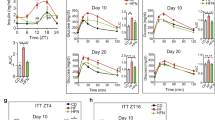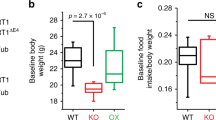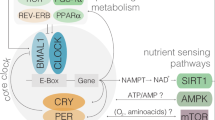Abstract
Background:
A new negative feedback loop has been proposed, which suggests connections between the circadian clock and SIRTUIN1 (SIRT1)-dependent functions associated with cell survival, development and metabolism.
Objective:
To develop a SIRT1 and circadian locomotor output cycles kaput (CLOCK) combined genotype and to assess its associations with the chronotype of subjects and their potential resistance to weight loss in a behavioral treatment for obesity based on a Mediterranean diet.
Design:
Overweight /obese subjects (n=1465), aged 20-65 years, who attended outpatient obesity clinics, were genotyped for SIRT1 (rs1467568) and CLOCK (3111T>C, rs1801260). Anthropometric, biochemical and dietary-intake variables were analyzed. Effectiveness of the program and weight loss progression during 30 weeks of treatment was assessed.
Results:
We found highly consistent associations between the morning/evening questionnaires across the different genotype categories. Subjects carrying minor alleles at SIRT1 and CLOCK loci (R group) displayed a higher resistance to weight loss and a lower weekly weight loss rate as compared with homozygotes for both major alleles (P group). Significant differences were found across genotypes in weight loss progression during the 30 weeks of treatment (P=0.039). Dietary habits indicated that R carriers had a lower intake of total carbohydrates and monounsaturated fats, and a higher intake of saturated fats than those carrying the intermediate (M) and the P genotype (P=0.02). Plasma ghrelin concentrations were also significantly higher in subjects carrying the R genotype.
Conclusion:
Variants of both SIRT1 and CLOCK have an additive effect on resistance to weight loss that could be related to the chronotype of the subject, higher plasma levels of ghrelin and less adherence to Mediterranean diet patterns.
This is a preview of subscription content, access via your institution
Access options
Subscribe to this journal
Receive 12 print issues and online access
$259.00 per year
only $21.58 per issue
Buy this article
- Purchase on Springer Link
- Instant access to full article PDF
Prices may be subject to local taxes which are calculated during checkout


Similar content being viewed by others
References
Garaulet M, Madrid JA . Chronobiological aspects of nutrition, metabolic syndrome and obesity. Adv Drug Deliv Rev 2010; 62: 967–978.
Maury E, Ramsey KM, Bass J . Circadian rhythms and metabolic syndrome: from experimental genetics to human disease. Circ Res 2010; 106: 447–462.
Wijnen H . Circadian rhythms. A circadian loop asSIRTs itself. Science 2009; 324: 598–599.
Rodgers JT, Lerin C, Gerhart-Hines Z, Puigserver P . Metabolic adaptations through the PGC-1 alpha and SIRT1 pathways. FEBS Lett 2008; 582: 46–53.
Doi M, Hirayama J, Sassone-Corsi P . Circadian regulator CLOCK is a histone acetyltransferase. Cell 2006; 125: 497–508.
Nakahata Y, Sahar S, Astarita G, Kaluzova M, Sassone-Corsi P . Circadian control of the NAD+ salvage pathway by CLOCK-SIRT1. Science 2009; 324: 654–657.
Nakahata Y, Kaluzova M, Grimaldi B, Sahar S, Hirayama J, Chen D et al. The NAD+-dependent deacetylase SIRT1 modulates CLOCK-mediated chromatin remodeling and circadian control. Cell 2008; 134: 329–340.
Bechtold DA . Energy-responsive timekeeping. J Genet 2008; 87: 447–458.
Picard F, Kurtev M, Chung N, Topark-Ngarm A, Senawong T, Machado De Oliveira R et al. Sirt1 promotes fat mobilization in white adipocytes by repressing PPAR-gamma. Nature 2004; 429: 771–776.
Cakir I, Perello M, Lansari O, Messier NJ, Vaslet CA, Nillni EA . Hypothalamic Sirt1 regulates food intake in a rodent model system. PLoS One 2009; 4: e8322.
Zillikens MC, van Meurs JB, Rivadeneira F, Amin N, Hofman A, Oostra BA et al. SIRT1 genetic variation is related to BMI and risk of obesity. Diabetes 2009; 58: 2828–2834.
Sookoian S, Gemma C, Gianotti TF, Burgueño A, Castaño G, Pirola CJ . Genetic variants of Clock transcription factor are associated with individual susceptibility to obesity. Am J Clin Nutr 2008; 87: 1606–1615.
Garaulet M, Lee YC, Shen J, Parnell LD, Arnett DK, Tsai MY et al. CLOCK genetic variation and metabolic syndrome risk: modulation by monounsaturated fatty acids. Am J Clin Nutr 2009; 90: 1466–1475.
Garaulet M, Corbalán MD, Madrid JA, Morales E, Baraza JC, Lee YC et al. CLOCK gene is implicated in weight reduction in obese patients participating in a dietary programme based on the Mediterranean diet. Int J Obes (Lond) 2010; 34: 516–523.
Garaulet M, Sánchez-Moreno C, Smith CE, Lee YC, Nicolás F, Ordovás JM . Ghrelin, sleep reduction and evening preference: relationships to CLOCK 3111 T/C SNP and weight loss. PLoS One 2011; 6: e17435.
Garaulet M, Pérez-Llamas F, Zamora S, Tebar FJ . Weight loss and possible reasons for dropping out of a dietary/behavioural programme in the treatment of overweight patients. J Hum Nutr Diet 1999; 12: 219–227.
Corbalán MD, Morales EM, Canteras M, Espallardo A, Hernández T, Garaulet M . Effectiveness of cognitive-behavioral therapy based on the Mediterranean diet for the treatment of obesity. Nutrition 2009; 25: 861–869.
Serra-Majem L, Aranceta J . Spanish Society of Community Nutrition. Nutritional objectives for the Spanish population. Consensus from the Spanish Society of Community Nutrition. Public Health Nutr 2001; 4: 1409–1413.
Ferrario VF, Sforza C, Schmitz JH, Miani Jr A, Taroni G . Fourier analysis of human soft tissue facial shape: sex differences in normal adults. J Anat 1995; 187 (Part 3): 593–602.
Horne JA, Ostberg O . A self-assessment questionnaire to determine morningness-eveningness in human circadian rhythms. Int J Chronobiol 1976; 4: 97–110.
Taillard J, Philip P, Chastang JF, Bioulac B . Validation of Horne and Ostberg morningness-eveningness questionnaire in a middle-aged population of French workers. J Biol Rhythms 2004; 19: 76–86.
Pérez-Llamas F, Garaulet M, Herrero F, Palma JT, Pérez de Heredia F, Marín R et al. Multivalent informatics application for studies of the nutritional status of the population. Assessment of food intake. Nutr Hosp 2004; 19: 160–166. (Article in Spanish).
Mataix J, Mañas M, Llopis J, Martínez M . Table of Composition Of Spanish Foods. Instituto de Nutrición y Tecnología, Universidad de Granada: Granada, Spain, 1996 (Book in Spanish).
Moreiras O, Carvajal A, Cabrera L . Tables of composition of foods. Pirámide SA: Madrid, 1995 (Book in Spanish).
Trichopoulou A, Yiannakouris N, Bamia C, Benetou V, Trichopoulos D, Ordovas JM . Genetic predisposition, nongenetic risk factors, and coronary infarct. Arch Intern Med 2008; 168: 891–896.
Morrison AC, Bare LA, Chambless LE, Ellis SG, Malloy M, Kane JP et al. Prediction of coronary heart disease risk using a genetic risk score: the Atherosclerosis Risk in Communities Study. Am J Epidemiol 2007; 166: 28–35.
Kathiresan S, Melander O, Anevski D, Guiducci C, Burtt NP, Roos C et al. Polymorphisms associated with cholesterol and risk of cardiovascular events. N Engl J Med 2008; 358: 1240–1249.
Mishima K, Tozawa T, Satoh K, Saitoh H, Mishima Y . The 3111T/C polymorphism of hClock is associated with evening preference and delayed sleep timing in a Japanese population sample. Am J Med Genet B Neuropsychiatr Genet 2005; 133B: 101–104.
Dijk DJ, Archer SN . PERIOD3, circadian phenotypes, and sleep homeostasis. Sleep Med Rev 2010; 14: 151–160.
Mendlewicz J . Disruption of the circadian timing systems: molecular mechanisms in mood disorders. CNS Drugs 2009; 23 (Suppl 2): 15–26.
Lee KY, Song JY, Kim SH, Kim SC, Joo EJ, Ahn YM et al. Association between CLOCK 3111T/C and preferred circadian phase in Korean patients with bipolar disorder. Prog Neuropsychopharmacol Biol Psychiatry 2010; 34: 1196–1201.
Eng S, Wagstaff DA, Kranz S . Eating late in the evening is associated with childhood obesity in some age groups but not in all children: the relationship between time of consumption and body weight status in US children. Int J Behav Nutr Phys Act 2009; 6: 27.
Striegel-Moore RH, Rosselli F, Wilson GT, Perrin N, Harvey K, DeBar L . Nocturnal eating: association with binge eating, obesity, and psychological distress. Int J Eat Disord 2010; 43: 520–526.
Frescas D, Valenti L, Accili D . Nuclear trapping of the forkhead transcription factor FoxO1 via Sirt-dependent deacetylation promotes expression of glucogenetic genes. J Biol Chem 2005; 280: 20589–20595.
Rodgers JT, Lerin C, Haas W, Gygi SP, Spiegelman BM, Puigserver P . Nutrient control of glucose homeostasis through a complex of PGC-1alpha and SIRT1. Nature 2005; 434: 113–118.
Mendoza J, Pévet P, Challet E . High-fat feeding alters the clock synchronization to light. J Physiol 2008; 586 (Part 24): 5901–5910.
Deng XQ, Chen LL, Li NX . The expression of SIRT1 in nonalcoholic fatty liver disease induced by high-fat diet in rats. Liver Int 2007; 27: 708–715.
Ramadori G, Lee CE, Bookout AL, Lee S, Williams KW, Anderson J et al. Brain SIRT1: anatomical distribution and regulation by energy availability. J Neurosci 2008; 28: 9989–9996.
Cantó C, Gerhart-Hines Z, Feige JN, Lagouge M, Noriega L, Milne JC et al. AMPK regulates energy expenditure by modulating NAD+ metabolism and SIRT1 activity. Nature 2009; 458: 1056–1060.
Xue B, Kahn BB . AMPK integrates nutrient and hormonal signals to regulate food intake and energy balance through effects in the hypothalamus and peripheral tissues. J Physiol 2006; 574 (Part 1): 73–83.
Korbonits M, Goldstone AP, Gueorguiev M, Grossman AB . Ghrelin--a hormone with multiple functions. Front Neuroendocrinol 2004; 25: 27–68.
Cota D, Proulx K, Smith KA, Kozma SC, Thomas G, Woods SC et al. Hypothalamic mTOR signaling regulates food intake. Science 2006; 312: 927–930.
Blouet C, Ono H, Schwartz GJ . Mediobasal hypothalamic p70 S6 kinase 1 modulates the control of energy homeostasis. Cell Metab 2008; 8: 459–467.
Acknowledgements
This work was supported by the Government of Education, Science and Research of Murcia (Project BIO/FFA 07/01-0004) and by the Spanish Government of Science and Innovation (projects AGL2008-01655/ALI) National Heart, Lung, and Blood Institute Grants HL-54776, National Institute of Diabetes and Digestive and Kidney Diseases, Grant Number DK075030 and by contracts 53-K06-5-10 and 58-1950-9-001 from the US Department of Agriculture Research.
Author information
Authors and Affiliations
Corresponding author
Ethics declarations
Competing interests
The authors declare no conflict of interest.
Rights and permissions
About this article
Cite this article
Garaulet, M., Esteban Tardido, A., Lee, YC. et al. SIRT1 and CLOCK 3111T>C combined genotype is associated with evening preference and weight loss resistance in a behavioral therapy treatment for obesity. Int J Obes 36, 1436–1441 (2012). https://doi.org/10.1038/ijo.2011.270
Received:
Revised:
Accepted:
Published:
Issue Date:
DOI: https://doi.org/10.1038/ijo.2011.270
Keywords
This article is cited by
-
Alignment between timing of ‘highest caloric intake’ and chronotype in relation to body composition during adolescence: the DONALD Study
European Journal of Nutrition (2024)
-
Association between CLOCK 3111 T/C polymorphism with ghrelin, GLP-1, food timing, sleep and chronotype in overweight and obese Iranian adults
BMC Endocrine Disorders (2022)
-
The association between sleep health and weight change during a 12-month behavioral weight loss intervention
International Journal of Obesity (2021)
-
Circadian CLOCK gene polymorphisms in relation to sleep patterns and obesity in African Americans: findings from the Jackson heart study
BMC Genetics (2017)
-
Regulation of the clock gene expression in human adipose tissue by weight loss
International Journal of Obesity (2016)



